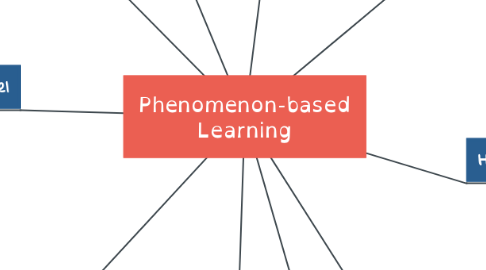Phenomenon-based Learning
by Sutinee Rapeetasanapong

1. Definition
1.1. Phenomenon-based Learning (PhBL) is a learner-centred, multidisciplinary instructional approach that is based on student inquiry and problem solving. Learners investigate and solve their own questions by applying what subjects are relevant to the problem.
1.1.1. For example, to understand and solve a question about climate change, knowledge from different subjects such as science, geography, mathematics, and history may be needed.
1.2. Origin of PhBL is in a 2016 education movement in Finland’s educational system. The revised education system asks that students take one module each year with the phenomenon-based learning approach.
1.3. Examples of phenomena can include such topics as climate change, the European Union, media and technology, water or energy.
2. Theory
2.1. PhBL has its roots in constructivist learning theory, socio-constructivist learning theory, and sociocultural learning theory. These theories propose that learning is best achieved by the learner actively constructing their own knowledge and experience, instead of by passive instruction.
2.2. Sharing a similar theoretical framework, PhBL has a lot in common with problem-based learning and inquiry-based learning.
3. Model
3.1. 1. Learners ask a question that relates to real life that is of personal interest.
3.2. 2. Learners engage in research to find a solution by studying the topic from different angles and perspectives.
3.3. 3. Instructors facilitate the process by guiding students to learn the concepts and skills needed to solve the problem.
3.4. 4. Learners present and deliver their solution in a chosen format.
4. Strengths
4.1. Fosters greater engagement in learning new knowledge and skills because learners are working towards what interests them personally.
4.2. Enables deeper learning because learners are making connections across subjects and seeing practical relevance to real life.
4.3. Learners develop stronger skills in communication, teamwork, critical thinking, and problem solving.
4.4. Learners become more independent as they become responsible for their own learning; this helps to create a more independent, self-sufficient workforce.
5. Teacher’s role
5.1. Teachers are seen as facilitators of learning tasks, who use their expertise not necessarily to transmit facts.
5.2. To make sure students know the foundational knowledge they need on a given topic to even consider developing a research question within it.
5.3. To teach students how to craft appropriate research questions that can lead to interesting and engaging, and hopefully even original, research opportunities.
5.4. To pause the student-directed investigations to teach and model the skills students should be using on their own along the way.
5.5. To encourage and guide students to deal with a problem that students themselves have identified.
5.6. To guide and organize the learning process rather than strictly provide knowledge.
6. Purpose
6.1. To prepare learners to solve problems in real life.
7. Five dimensions
7.1. 1. Holisticity refers to the multidisciplinarity of PhBL.
7.2. 2. Authenticity implies the use of methods, tools and materials, which are necessary in real-world situations to solve problems that are relevant to students’ lives and significant in the community.
7.3. 3. Contextuality refers to learning of phenomena as systemic entities, which are meaningful in a natural context and setting.
7.4. 4. Problem-based inquiry learning. Students pose their own questions and collaboratively construct knowledge during the learning process, which is considered an intentional process of developing hypotheses and working theories.
7.5. 5. Learning process. The students themselves plan the learning process by creating their own learning tasks and tools.
8. Weaknesses
8.1. If the teacher wants learners to achieve specific learning goal, PhBL may not be the answer. There are no imposed learning goals in PhBL because they are created during the learning process.
8.2. Resources and support need to be available for learners to tackle self-led projects. Without a facilitator, learners may struggle to identify and learn the skills and knowledge.
8.3. PhBL is characterized by its lack of formal structure. It is not suitable for the school which requires a formal structure where learners need to show completion of skills or knowledge required.
8.4. If feedback and assessment are important to the school, this may be more difficult with PhBL, where assessment is mainly based on learner progress.
9. How to set-up PhBL for learners
9.1. 1. Have learners choose a “phenomena” from the real world; the topic should have a global context and be related to real life issues or events.
9.2. 2. Develop an inquiry question around this topic that begins with either “how”, “why” or “what if?”
9.3. 3. Identify and teach the basic concepts that pertain to the learner’s chosen question; what skills or knowledge will they need to solve the problem?
9.4. 4. Ensure that there is an open structure of time for learners to engage in the necessary research and problem solving.
9.5. 5. Facilitate the process by setting up a framework that will help guide students through the process and develop their own way of solving the problem.
10. Student’s role
10.1. Students are seen as active participants who engage in social construction of knowledge.
10.2. Students engage in learning that has more context to real life issues, apply knowledge and skills from different subjects, and develop important skills like communication, critical thinking, problem solving, and teamwork.


